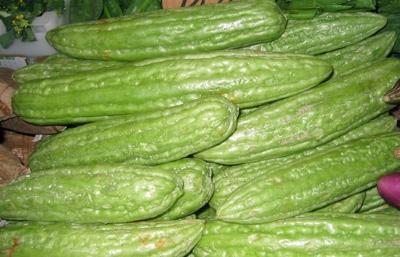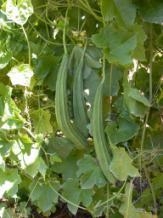
At certain roadside stands, at farmers markets that cater to diverse clientele and in small Asian supermarkets, adventurous Californians can buy vegetables like bitter melon, Chinese long beans, opo and luffa. Finding them is the first step, knowing how to prepare them is another matter. UC Cooperative Extension has made these less familiar vegetables more accessible by creating a collection of easy-to-cook and nutritious Southeast Asian vegetable recipes.
The recipes were developed by UCCE nutrition educators in Fresno and the statewide UC Expanded Food and Nutrition Education Program team with Richard Molinar, a UCCE advisor in Fresno County. Connie Schneider, director of the UC Youth, Families and Communities Program, and Molinar started by researching the traditional usage of Asian vegetables. They modified some ingredients and procedures in the recipes to simplify preparation and improve the nutritional profile.
“We minimized the number of ingredients in each recipe, added clear measurements and tested the dishes,” Schneider said. “They are delicious.”
For the last 18 years, Molinar has worked with small-scale farmers in Fresno County, which boasts the largest concentration of Hmong farmers in the U.S. Fresno County is also home to farmers of other ethnicities from Laos, China and Vietnam. Molinar and his assistant, Michael Yang, have introduced Southeast Asian immigrant farmers to the latest farming technologies, helped them develop plans to ensure the safety of the food they grow, and worked with them to find new marketing opportunities. Many of these farmers have begun growing vegetables common in California, and most have also kept some space on the farm for the vegetables of their homelands.
The UCCE educators recognized that the rich culinary traditions of local Southeast Asian immigrants could be adapted and used by people of all cultures to increase their consumption of vegetables. Besides, encouraging consumption of Southeast Asian vegetables adds new marketing opportunities for the farmers.
“This has been a unique opportunity to bring UCCE’s farm advisors and nutrition educators together to assist farmers and the public,” Molinar said. “These recipes will encourage more people to buy these nutritious vegetables, expanding the market for the growers.”
The 12 recipes are printed on cards, each with photos of the fresh vegetable and background information. For example, the recipe card for “bitter melon stir fry” notes that the crinkly skinned vegetable is native to India and is eaten when young and green, as bitterness increases with age. The recipe is accompanied by a photo of the prepared dish and complete nutrition facts per serving.

"I grew up with zucchini," Molinar said, "but I prefer the flavor and texture of angled luffa."
The printed cards will be distributed at farmers markets where Southeast Asian vegetables are sold, and they are available on the Fresno County UC Cooperative Extension website. Farmers who sell Asian vegetables at farmers markets may pick up 10 packets of recipes for free at the UC Cooperative Extension in Fresno, 1720 S. Maple Ave., Fresno. Direct links to each of the recipes are below:
- Bitter Melon Stir Fry
- Chinese Long Bean and Tofu Salad
- Chinese Winter Melon Chicken Soup
- Field of Greens Salad
- Fuzzy Gourd Stuffed with Pork and Mushrooms
- Lemongrass Chicken Soup
- Luffa and Prawns
- Marinated Japanese Eggplant
- Opo and Beef
- Snow Pea Daikon Salad
- Strawberry Spring Rolls
- Spicy Shrimp and Bok Choy Noodle Bowl
Following are two sample recipes:
Bitter Melon Sir Fry
Serves 4
Ingredients:
1 ripe bitter melon, seeded and sliced
1 tablespoon olive oil
1 onion, diced
3 garlic cloves, crushed
½ lb. ground pork
½ lb. medium shrimp, peeled and deveined
1 tomato, chopped
1 tablespoon reduced sodium soy sauce
Pepper to taste
Directions:
- Place sliced bitter melon in boiling water until just tender (2-3 minutes). Drain
- Heat olive oil in skillet over medium heat. Sauté onions for about 5 minutes until tender.
- Add garlic; sauté an additional 2 minutes; mix in pork and cook until no longer pink.
- Add shrimp; cook about 5 minutes until done.
- Add tomato, bitter melon, and soy sauce; cook until tender.
Luffa and Prawns
Serves 4
Ingredients:
1 tablespoon vegetable oil
1 garlic clove, minced
1 lb large prawns, peeled and deveined
2 luffa (angled luffa or smooth luffa), chopped
¼ cup bamboo shoots
1 teaspoon coriander
1 tablespoon reduced sodium soy sauce
1 green onion, sliced
Directions:
- Heat oil in a wok/pan; add garlic and stir fry for 1 minute.
- Add prawns; cook until done
- Add luffa; continue to stir fry with prawns until just tender, about 5 minutes.
- Add bamboo shoots, coriander, and soy sauce to pan and stir fry a few minutes
- Sprinkle with green onion and serve.